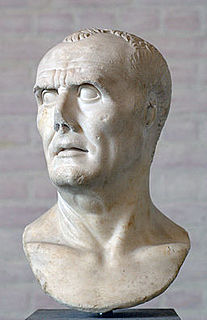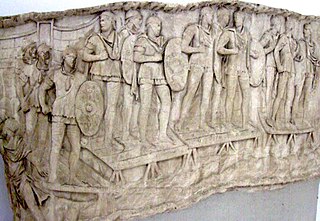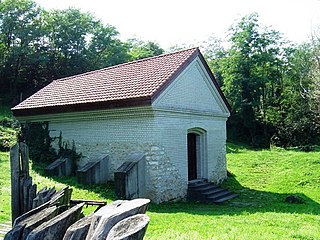The Roman legion was the largest military unit of the Roman army, composed of 4,200 infantry and 300 equites (cavalry) in the period of the Roman Republic ; and was composed of 5,200 infantry and 120 auxilia in the period of the Roman Empire

Pannonia was a province of the Roman Empire bounded on the north and east by the Danube, coterminous westward with Noricum and upper Italy, and southward with Dalmatia and upper Moesia. Pannonia was located in the territory of present-day western Hungary, eastern Austria, northern Croatia, north-western Serbia, northern Slovenia and northern Bosnia and Herzegovina.

The Praetorian Guard was a unit of the Imperial Roman army that served as personal bodyguards and intelligence agents for the Roman emperors. During the Roman Republic, the Praetorian Guard were an escort for high-rank political officials and were bodyguards for the senior officers of the Roman legions. In the year 27 BC, after Rome's transition from republic to empire, the first Emperor of Rome, Caesar Augustus, designated the Praetorians as his personal security escort. For three centuries, the guards of the Roman emperor were also known for their palace intrigues, by which influence upon imperial politics the Praetorians could overthrow an emperor, and then proclaim his successor as the new Caesar of Rome. In AD 312, Constantine the Great disbanded the cohortes praetoriae and destroyed their barracks at the Castra Praetoria.

The Roman legionary was a professional heavy infantryman of the Roman army after the Marian reforms. These soldiers would conquer and defend the territories of ancient Rome during the late Republic and Principate eras, alongside auxiliary and cavalry detachments. At its height, Roman legionaries were viewed as the foremost fighting force in the Roman world, with commentators such as Vegetius praising their fighting effectiveness centuries after the classical Roman legionary disappeared.

The Revolt of the Batavi took place in the Roman province of Germania Inferior between AD 69 and 70. It was an uprising against the Roman Empire started by the Batavi, a small but militarily powerful Germanic tribe that inhabited Batavia, on the delta of the river Rhine. They were soon joined by the Celtic tribes from Gallia Belgica and some Germanic tribes.

Legio XXII Deiotariana was a legion of the Imperial Roman army, founded ca. 48 BC and disbanded during the Bar Kokhba revolt of 132–136. Its cognomen comes from Deiotarus, a Celtic king of Galatia. Its emblem is unknown.

The Roman army was the armed forces deployed by the Romans throughout the duration of Ancient Rome, from the Roman Kingdom to the Roman Republic and the Roman Empire, and its medieval continuation, the Eastern Roman Empire. It is thus a term that may span approximately 2,205 years, during which the Roman armed forces underwent numerous permutations in composition, organisation, equipment and tactics, while conserving a core of lasting traditions.

The Marian reforms were reforms of the ancient Roman army implemented in 107 BC by the statesman Gaius Marius, for whom they were later named. The reforms originated as a reaction to the military and logistical stagnation of the Roman Republic in the late 2nd century BC. Centuries of military campaigning throughout the Mediterranean and increasing invasions and uprisings across Roman territory had stretched the human and physical resources of the Roman army.

Vindobona was a Roman military camp on the site of the modern city of Vienna in Austria. The settlement area took on a new name in the 13th century, being changed to Berghof, or now simply known as Alter Berghof.

The Auxilia were introduced as non-citizen troops attached to the citizen legions by Augustus after his reorganisation of the Imperial Roman army from 30 BC. By the 2nd century, the Auxilia contained the same number of infantry as the legions and, in addition, provided almost all of the Roman army's cavalry and more specialised troops. The auxilia thus represented three-fifths of Rome's regular land forces at that time. Like their legionary counterparts, auxiliary recruits were mostly volunteers, not conscripts.
Lucius Petronius Taurus Volusianus was a Roman citizen, apparently of equestrian origins, whose career in the Imperial Service in the mid-Third Century AD carried him from a relatively modest station in life to the highest public offices and senatorial status in a very few years. He may have secured his first appointments before the Licinian Dynasty — — acceded to the Empire in 253 AD, but it was in the course of their reign that his upward progress achieved an almost unprecedented momentum and the second factor seems to have been a consequence of the first. The nature of his relationship to the Licinii is uncertain, but it seems likely that a common origin in the Etruscan region of central Italy at least predisposed Gallienus in his favour and he seems to have been that emperor's most trusted servant and adviser during the period of his sole reign - 260(?)-268 AD.
Aper was a Roman citizen of the third century AD. First known to history as a high-flying professional soldier, he went on to serve as an acting provincial governor and finally became Praetorian prefect, under the Emperor Carus - in effect vice principis. This rendered him hugely influential in the government of the empire - not excepting in matters of Peace and War.

The Fertőrákos Mithraeum is a temple to the Roman god Mithras at Fertőrákos in Hungary. The temple, follows a typical plan of a narthex followed by the shrine proper that consists of a sunken central nave with podium benches on either side.
Publius Aelianus Aelianus was a senior officer in the Imperial Roman army in the mid-Third Century AD who rose from relatively lowly origins to become the prefect of a legion under the Emperor Gallienus He was one of the earliest beneficiaries of Gallienus's policy that effectively excluded senators from army commands in favour of career-soldiers of equestrian rank. His later life is obscure.

Aquincum was an ancient city, situated on the northeastern borders of the province of Pannonia within the Roman Empire. The ruins of the city can be found today in Budapest, the capital city of Hungary. It is believed that Marcus Aurelius wrote at least part of his book Meditations at Aquincum.
The Imperial Roman army was the terrestrial armed forces deployed by the Roman Empire from about 30 BC to 476 AD, the final period in the long history of the Roman army. This period is sometimes split into the Principate and Dominate (285–476) periods.
Traianus Mucianus was a Roman soldier of Thracian origins of the second half of the Third Century AD who rose from the lowest ranks of the army to senior commands. He was almost certainly a remarkable soldier. However, the successive promotions he secured in the latter part of his career are thought to owe much also to the favour shown him by men highly placed in the Imperial entourage whose patronage secured him advantageous postings in the Imperial comitatus, the mobile field force under the direct command of the Emperor, that was undergoing massive expansion at this time.

The Cohors II Lucensium [equitata] was a Roman auxiliary unit. It is attested by military diplomas and inscriptions.
The timeline of Hungarian history lists the important historical events that took place in the territory of Hungary or are closely connected to the history of the country.